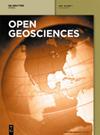Water transportation planning in connection with extreme weather conditions; case study – Port of Novi Sad, Serbia
IF 1.3
4区 地球科学
Q3 GEOSCIENCES, MULTIDISCIPLINARY
引用次数: 0
Abstract
The Danube has a length of 588 km in the Republic of Serbia. The water transport on this river is underused. The hazardous events have a great impact on the traffic on this river, and the understanding of these events is of great importance. This study focuses on hazardous events on the Danube with the main focus on the port of Novi. The hazardous events used in this study are extreme air temperatures, devastating winds, drought, and heavy precipitation. The hazardous events were represented using geographic information systems (GIS), geostatistics, and numerical methods. The potential of the river transport network and the port capacity were analyzed and compared with the hazardous events of the last 30 years. The results showed that three areas of the port are of great importance for port security, and two areas are extremely affected by hazardous events. The distance of the port of Novi Sad from heavy precipitation events is 6.8 km in the southwestern direction. The periods of extremely low precipitation (climatic drought) were in 1994, 2008, 2012, 2015, 2019, and 2021. Extreme average maximum temperatures were in 1995, 2008, 2010, 2013, 2015, and 2019. On the other hand, minimum average temperatures were in 1994, 1996, 1998, 1999, 2017, and 2018, and the strongest winds were in 1995, 1998, 2003, 2009, 2012, and 2014. The methods and techniques of GIS, used in this research, have confirmed new potential geographical positions of the port that can be better adapted to future climate changes. Another main objective of this research is to recommend better spatial planning and construction of new green corridors.与极端天气条件有关的水运规划;案例研究 - 塞尔维亚诺维萨德港
多瑙河在塞尔维亚共和国境内长 588 公里。这条河流上的水上交通利用率很低。危险事件对这条河流上的交通有很大影响,因此了解这些事件非常重要。本研究的重点是多瑙河上的危险事件,主要集中在诺维港。本研究中使用的危险事件包括极端气温、破坏性大风、干旱和强降水。危险事件使用地理信息系统 (GIS)、地质统计学和数值方法来表示。对河流运输网络的潜力和港口吞吐能力进行了分析,并与过去 30 年的灾害事件进行了比较。结果表明,港口的三个区域对港口安全非常重要,两个区域受危险事件的影响极大。诺维萨德港西南方向距离强降水事件的距离为 6.8 公里。降水量极低(气候干旱)的时期为 1994 年、2008 年、2012 年、2015 年、2019 年和 2021 年。极端平均最高气温出现在 1995 年、2008 年、2010 年、2013 年、2015 年和 2019 年。另一方面,最低平均气温出现在 1994 年、1996 年、1998 年、1999 年、2017 年和 2018 年,最强风出现在 1995 年、1998 年、2003 年、2009 年、2012 年和 2014 年。本研究中使用的地理信息系统方法和技术确认了港口新的潜在地理位置,可以更好地适应未来的气候变化。这项研究的另一个主要目的是建议更好地进行空间规划和建设新的绿色走廊。
本文章由计算机程序翻译,如有差异,请以英文原文为准。
求助全文
约1分钟内获得全文
求助全文
来源期刊

Open Geosciences
GEOSCIENCES, MULTIDISCIPLINARY-
CiteScore
3.10
自引率
10.00%
发文量
63
审稿时长
15 weeks
期刊介绍:
Open Geosciences (formerly Central European Journal of Geosciences - CEJG) is an open access, peer-reviewed journal publishing original research results from all fields of Earth Sciences such as: Atmospheric Sciences, Geology, Geophysics, Geography, Oceanography and Hydrology, Glaciology, Speleology, Volcanology, Soil Science, Palaeoecology, Geotourism, Geoinformatics, Geostatistics.
 求助内容:
求助内容: 应助结果提醒方式:
应助结果提醒方式:


